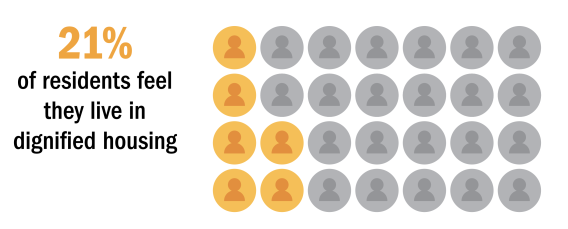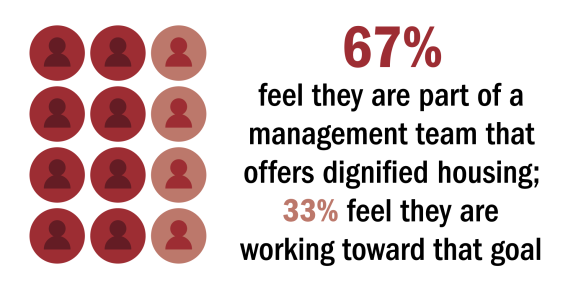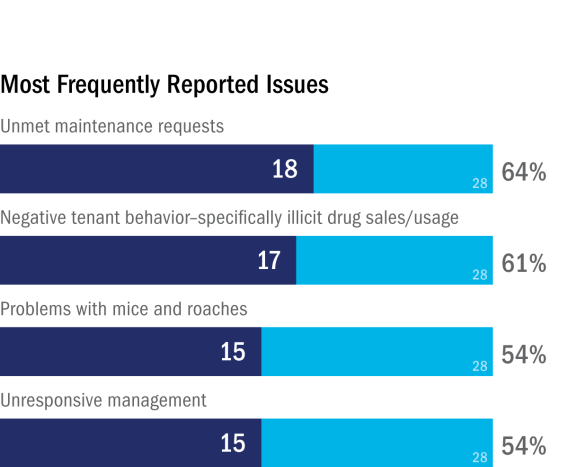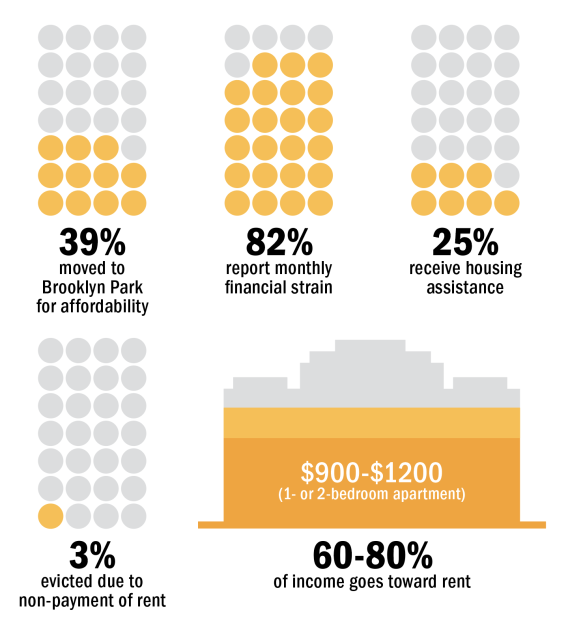To me it means that you don’t have to be worried about who might be coming into your building! Or who might be in the laundry room or storage area. Or who might be lurking around the building—that you can just go in your own apartment building. You should feel like you live there, you should be comfortable there. So yeah, that’s what makes me just feel safe. (BP02, Resident)
I know we provide dignified housing. It’s the bottom of these buildings. These are C-level apartment buildings and they could be run down. They’re not run down. They’re maintained. We check in on people. We are active in people’s lives. We know what’s going on in every household, good or bad. It’s not all necessarily good, but we’re aware of it. (BP25, Owner)
A central question asked of all participants was whether they felt they lived in or offered dignified housing. It became clear early on that individual’s responses, especially residents, were relative and based upon past and present housing experiences. For example, where in the city a participant resided shaped their response. Also, the living situation that a person transitioned from—in particular homelessness or a community with overt violence mattered. Staff turnover rates or the sale of a building transforming its culture, for better or worse, mattered. The role of assistance programs such as section 8, PPL Cabrini, or Simpson Housing—shaping housing experiences and the options available in the market was important. And finally, participants understood that the city’s housing stock was tiered and that the communities present in this study were not the city’s luxury or higher-end apartments. As one participant, who felt she lived in a nicer community within the city’s more affordable housing stock, put it: “I feel dignified within the scope of mediocrity.” Ultimately, the role of neighbors, location within the city, and a management team’s approach or staff culture informed how participants responded.
|
Do you live in Dignified Housing? Yes = 6 / N =22 |
Do you feel you’re a part of a management team that offers Dignified Housing? Y= 8 / Working Toward = 4 |
|---|
Dignified Housing


RESIDENTS
Unpacking the above graphic, no resident was outright pleased by their apartment community. Even those who stated “yes,” finding more strengths than weaknesses in their housing experience, still had negative encounters with either management or neighbors. For those individuals who answered “yes” and felt they did live in dignified housing, they based their responses on the following.
Accessible green spaces and transit
Well, after seeing the community. I really liked the campus with the trees and the common areas, but also that it was big enough where I could go sit on the lawn and read or something. And I like that there’s a bus stop right outside the parking lot because I rely on the bus a lot, so to be close to a bus stop is awesome. And they do have an exercise room and some pools. So that’s really nice for me too. (BP01)
I moved here and stayed here because I love the fact that I live two blocks away from Riverview Park and it’s beautiful—it’s lovely. I bring my bike there now. I hike there. And when I was going through some mental health challenges my partner and I go there and walk. (BP21)
Management culture that met tenants where they were
I like management because if I was 30 or 40 dollars short with my rent and I couldn’t swing it, I would just pay it the next month. He would have no problem with it. I could call him, and that’s one thing about him, I could call him and talk to him about anything. He was really like a friend to me and my family. (BP37)
Over the years, you know, he’s just easier to talk to. Easy to get along with. He ran his apartments with no rodent problems. No wondering who’s in your apartment building. What are they doing in there—none of that. He got his rent on time. And if I had a problem, getting him all of the rent, I get him most of the rent and then I’d come back and give him the rest before the end of the month. And he would just, he would work with you. Like he cared about people…I knew I wasn’t going to be getting threatened to get evicted. (BP36)
Location and basic safety provisions that the average renter should be able to take for granted
So I feel a bit, it’s in a lovelier neighborhood. Or it’s in a more affluent neighborhood, closer to parks, community access, and amenities—which is really cool. So [as a city renter] I kind of feel a bit like, I’m a tolerable riff-raff in a way. I feel kind of bad. I don’t feel like my experiences are exactly similar to other renters in Brooklyn Park. Like, yeah I deal with crap, but it’s a bit nicer here. I don’t have many challenges as are noted in other apartment communities, the buildings look a bit nicer, and it’s a nicer neighborhood. And that may contribute to having a better experience...There are no security guards. No cameras. Never have issue with people propping the door open. Never have issues like, [3rd person, petulant tone] “oh, did you see that guy sleeping in the hallway? He looks so creepy.” Nope, don’t have that. Or like “did you see those teen boys run around? I feel a little scared. They’re looking at me too long.” Nope, nothing. I feel great. (BP21)
However, what was more common amongst participants was saying “no,” that they did not feel they lived in dignified housing. Their reasoning fell into three broad categories: mismatch between housing quality and rental price, forced financial investments, and extreme health and safety hazards.
Mismatch Between Housing quality and Rental Price

Within this category the most frequently reported issues related to unmet maintenance requests, problems with mice and roaches, negative tenant behavior—specifically illicit drug usage and sale, and unresponsive management.
Unmet maintenance requests (18/28)
They take so long! I did a maintenance request (shaking head) for the refrigerator. They came out, looked at the refrigerator, and saw the leaks. He told me it wasn’t leaking. Then I called back and another guy came for another maintenance issue. I told him about the refrigerator, he said, “Is something wrong in the refrigerator?” The guy who looked at it first said it wasn’t nothing wrong with what he looked at, but the second guy said there was something wrong, but they still never came and touched the refrigerator yet. Man, that was maybe a month or two, like a month, a month ago. I know they forgot me. It’s just crazy. I got to throw away stuff because the refrigerator, it’ll freeze sometimes then it starts unthawing, dripping on the bottom. Then it’ll freeze again. So it’s like, all my stuff in the bottom will have ice on it. Then it just melts. It’s constant. Constant request after request after request. And then they take, one time it took like four or five weeks for them to come. I kept calling them back. They like, “Yeah, we see you did a request.” (shakes/tosses head in frustration) No urgency. (BP09)
According to the survey results collected in this study, about half of the respondents’ monthly income was lower than $1,500, and four of the participants brought home less than $500 each month. The importance of affordable housing was something most every participant spoke to during their interview, but challenges existed before and/or during the pandemic that placed increased strain, for many, on housing situations.
Before the Pandemic
Affordability, with conditions

Financial Strain in Housing
Among the 28 interviewed residents, 11 (39%) indicated that affordability was one of the reasons that prompted them to move to Brooklyn Park. However, through this research project we learned that affordability was not always sustainable. Only five of the project participants shared that they did not suffer from financial strain each month when paying their rent, utilities, and building maintenance fees.
BP21 was excited about the affordability of apartments in this area, as she said, “Compared to other apartments, these apartments are of better quality, so it feels weird for me because they’re also the least expensive. They used to be $715 [five years ago]. I’m like, ‘Oh my God! That’s so cool!’” But she also mentioned that, “the price keeps increasing without any amenities or additional support.” BP03 expressed a similar comment—”I’ll say it was the only place that I could actually afford… I pay $880 for a one-bedroom apartment. There’s not a swimming pool. There are not really a lot of amenities.” BP34 was looking for a place to move, but “right now I’m having another baby. I can’t afford it.”
For the residents interviewed in this study, a one-bedroom apartment (priced around $900 to $1,200 per month) and two-bedroom apartment (priced around $1,200) would cost 60% to 80% of their income.[146] One participant shared that they had experienced an eviction due to non-payment of rent. Seven participants (25%) indicated that assistance from housing programs (e.g., Section 8) allowed them to afford rental properties within the city.
Section 8—Yeah, that’s the only way I can afford the rent nowadays. (BP37)
Affordability, challenged by rising rent
Rising rent prices are not an issue unique to the City of Brooklyn Park. With changes in population, the housing market, and inflation, rent increases are inevitable. Though a national trend, in recent years, the Twin Cities metro area has seenan increase in the trade and renovation of older properties, exacerbating the loss of affordable housing.[147] This situation happened to BP10, who used to live in Minneapolis and was forced to move after a sale and major apartment renovation.
“And then what happened was that [the apartment building was sold to another owner]. Then, they put all this fancy equipment in there for the workout room and all this fancy stuff for the rich... I don’t want to stereotype but [the new owner] bought it and hooked it up, put dishwashers in every apartment and all this different stuff, and charged crazy rent. I couldn’t afford it. So I had to move.” (BP10)
The result of the Brooklyn Park Apartment Vacancy Survey[148] shows that, between 2016 and 2019, the median rent for one-bedroom apartments increased 14% from $822 to $940, and the median rent for two-bedroom apartments increased 16% from $979 to $1,132. The rising rent